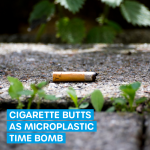
Cigarette Butts as a Microplastic Time Bomb
8. September 2025
Microplastics in Beer
20. September 2025Organic Phosphonates in Detergents: An Unrecognized Source of Glyphosate and Disruptive Factor in Wastewater Treatment
The contamination of European waters with glyphosate and its degradation product AMPA (aminomethylphosphonic acid) has so far been attributed exclusively to the use of the herbicides in agriculture. However, current research shows a completely different picture: A large portion of glyphosate pollution in European rivers may not originate from herbicide application, but from a completely unexpected source – organic phosphonates in detergents.
What are organic phosphonates?
Organic phosphonates are synthetic complexing agents that contain a stable carbon-phosphorus bond. The most important representatives are:
- DTPMP (Diethylenetriaminepenta(methylenephosphonate)) – the most significant by volume
- EDTMP (Ethylenediaminetetra(methylenephosphonate))
- ATMP (Aminotris(methylenephosphonate))
These compounds are used in enormous quantities in Europe: 49,000 tons per year (as of 2012), of which 7,613 tons alone are in German household cleaners (2019). They serve as complexing agents for calcium and magnesium ions and thus prevent lime deposits in washing machines and pipelines.
The Transformation Mechanism: How Detergent Additives Become Glyphosate and the Key Factor Manganese
A groundbreaking study by the University of Tübingen was able to experimentally demonstrate for the first time in 2025 that DTPMP is transformed into glyphosate through reaction with manganese at neutral pH. Both dissolved Mn²⁺ with oxygen and suspended manganese oxides (MnO₂) lead to glyphosate formation.
The reaction proceeds through several stages:
- C-N bond cleavage in the ethylene unit of the DTPMP molecule
- Oxidation of the terminal carbon group to aldehyde
- Further oxidation to carboxylic acid, creating the structure characteristic of glyphosate
The glyphosate yields are low (up to 0.42 mol%), but quite relevant given the enormous amounts of phosphonates consumed. Remarkably, glyphosate and AMPA remain stable after complete DTPMP transformation and are not further degraded.
Formation of AMPA: A Persistent Metabolite
AMPA is formed in two ways:
- As a degradation product of glyphosate (traditional pathway)
- Directly from phosphonates through two C-N bond cleavages
AMPA is significantly more persistent than glyphosate with a half-life of 119 to 985 days. In urban areas, AMPA mainly originates from phosphonates and glyphosate in wastewater and is regularly detected in wastewater treatment plant effluents.
Effects on Water Quality: Eutrophication through Phosphate Release and Toxicological Concerns
Although phosphonates are very stable against biological degradation, they contribute to eutrophication through:
- Photolytic degradation under UV radiation, which releases orthophosphate
- Manganese-catalyzed oxidation, which also leads to phosphate formation
- Long-term abiotic degradation in surface waters
The delayed phosphate release can promote eutrophication and is particularly problematic because it is difficult to predict.
While the phosphonates themselves are considered moderately toxic to aquatic organisms, their degradation products are classified as particularly critical:
- Glyphosate: Controversially discussed herbicide with possible health risks
- AMPA: Lack of epidemiological data on toxicological effects in humans
Interference with Phosphate Precipitation in Wastewater Treatment Plants through Complexation of Precipitants
Phosphonates can bind precipitants as complexing agents and thus significantly disrupt phosphate precipitation in wastewater treatment plants:
- Increased chemical demand: Precipitants must be dosed in large excess
- pH shifts: Acidification can impair nitrification
- Lack of bioavailable phosphate: Complexation of phosphate compounds important for biological processes. .
Impairment of Modern Processes
The Enhanced Biological Phosphorus Removal (EBPR) can be particularly affected by phosphonates, as these processes are based on precise control of phosphate availability. Phosphonates at high concentrations can significantly disrupt phosphate precipitation processes.
Removal by Wastewater Treatment Plants: High Removal Rates through Adsorption
Despite their biological persistence, phosphonates are eliminated by wastewater treatment plants with removal rates of over 80%. The main mechanisms are:
- Adsorption to activated sludge: Particularly to amorphous iron oxides in the sludge
- Complexation with metal ions: pH-dependent binding to calcium and magnesium
- Chemical precipitation: In the presence of precipitants such as iron or aluminum salts
Problem Area: Accumulation in Sewage Sludge
A study in textile wastewater treatment plants found significant accumulations of phosphonates in dewatered sludge (up to 7.81 g/kg). This raises questions about sewage sludge utilization and possible environmental risks.
Analytical Challenges
The difficult analysis of phosphonates in trace concentrations has long contributed to their environmental behavior being little researched:
- Method development: In 2021, the Federal Environment Agency conducted studies to improve analytical methods
- Matrix effects: Complex wastewater matrices complicate quantification
- Speciation: Distinction between different phosphonate species necessary
Innovative Removal Processes
Electrochemical processes can directly oxidize phosphonates to orthophosphate and simultaneously precipitate it as calcium phosphate. This enables both removal and phosphorus recovery.
UV/H₂O₂ treatment has been investigated as a promising approach for phosphonate removal, but shows limited efficiency compared to other AOPs. Studies with HEDP (1-hydroxyethane diphosphonic acid) showed that UV/H₂O₂ alone achieves only about 20% degradation, while combined processes are significantly more effective.
UV/chlorine systems prove to be significantly more efficient than UV/H₂O₂ for phosphonate degradation. In HEDP treatment, UV/chlorine showed a higher degradation performance at lower oxidant concentrations (0.1-0.5 mM). The process generates both hydroxyl radicals (•OH) and reactive chlorine species (RCS).
UV/persulfate activation shows excellent results for nitrogen-containing phosphonates such as NTMP and DTPMP. The reaction rate constants are high (k(SO₄•⁻) = 10⁷-10⁸ M⁻¹s⁻¹), and the process is more pH-independent than ozonation.
Optimization Aspects: The efficiency of AOPs strongly depends on operating parameters:
- pH value: Ozonation shows strong pH dependence, while radical-based processes are more stable
- Matrix effects: Real wastewaters reduce efficiency through radical scavengers and competing reactions
- Energy demand: UV-LEDs as an alternative to mercury lamps can reduce energy consumption
Special filter materials such as Polonite can selectively remove phosphonates through sorption processes, even though they were originally developed for phosphate.
Environmental Implications and Future Perspectives: We Need a Reassessment of Glyphosate Sources
The discovery of phosphonate-glyphosate transformation requires a reassessment of water protection strategies:
- Regulatory consequences: Restrictions on herbicide application alone may not be sufficient
- Industrial responsibility: Detergent manufacturers must develop alternative complexing agents
- Consumer behavior: Creating awareness of hidden sources of water pollution
Further Research is Needed, Particularly Comparative Studies that Reconsider the Complex Environmental Problem
Further investigations are urgently required:
- Field studies: Quantification of glyphosate formation in real wastewater treatment plants
- Intermediate identification: Elucidation of complete reaction pathways
- Alternative complexing agents: Development of more environmentally compatible substitutes
The recognition that detergent additives can transform into glyphosate turns our understanding of water pollution upside down. Organic phosphonates prove to be a multifactorial environmental problem:
- They interfere with wastewater treatment through the complexation of precipitants.
- They contribute to eutrophication through delayed phosphate release.
- They form toxicologically concerning degradation products such as glyphosate and AMPA.
- They accumulate in sewage sludge with unclear long-term consequences.
These findings underscore the necessity of a holistic approach to water protection that considers not only obvious sources such as pesticides but also hidden contamination sources from everyday products. The development of alternatives to phosphonates and improved removal processes at wastewater treatment plants are urgently required to ensure the quality of our waters in the long term.






